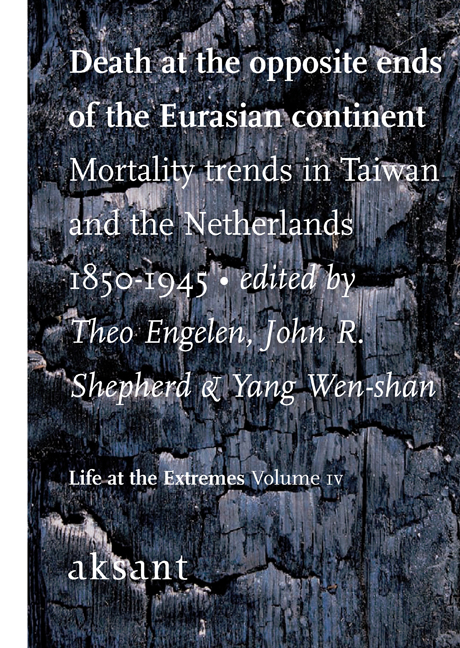 Death at the Opposite Ends of the Eurasian Continent
Death at the Opposite Ends of the Eurasian Continent Book contents
- Frontmatter
- Contents
- Introduction: Death at the Opposite Ends of the Eurasian Continent: Mortality Trends in Taiwan and the Netherlands, 1850-1945
- 1 Trends in Mortality and the Evolution of the Cause-of-death Pattern in the Netherlands: 1850-2000
- 2 Trends in Mortality and Causes of Death in Japanese Colonial Period Taiwan
- 3 Mortality in the Netherlands: General Development and Regional Differences
- 4 Regional and Ethnic Variation in Mortality in Japanese Colonial Period Taiwan
- 5 An Outline of Socio-medical Care in the Netherlands, 19th and Early 20th Centuries
- 6 An Overview of Public Health Development in Japan-ruled Taiwan
- 7 The Demographic History of Smallpox in the Netherlands, 18th-19th Centuries
- 8 Anti-malaria Policy in Colonial Taiwan
- 9 Maternal Mortality in Taiwan and the Netherlands, 1850-1945
- 10 Maternal Depletion and Infant Mortality
- 11 The Massacre of the Innocents: Infant Mortality in Lugang (Taiwan) and Nijmegen (the Netherlands)
- 12 Illegitimacy, Adoption, and Mortality Among Girls in Penghu, 1906-1945
- 13 How Reliable is Taiwan's Colonial Period Demographic Data?: An Empirical Study Using Demographic Indirect Estimation Techniques
- References
12 - Illegitimacy, Adoption, and Mortality Among Girls in Penghu, 1906-1945
Published online by Cambridge University Press: 22 January 2021
- Frontmatter
- Contents
- Introduction: Death at the Opposite Ends of the Eurasian Continent: Mortality Trends in Taiwan and the Netherlands, 1850-1945
- 1 Trends in Mortality and the Evolution of the Cause-of-death Pattern in the Netherlands: 1850-2000
- 2 Trends in Mortality and Causes of Death in Japanese Colonial Period Taiwan
- 3 Mortality in the Netherlands: General Development and Regional Differences
- 4 Regional and Ethnic Variation in Mortality in Japanese Colonial Period Taiwan
- 5 An Outline of Socio-medical Care in the Netherlands, 19th and Early 20th Centuries
- 6 An Overview of Public Health Development in Japan-ruled Taiwan
- 7 The Demographic History of Smallpox in the Netherlands, 18th-19th Centuries
- 8 Anti-malaria Policy in Colonial Taiwan
- 9 Maternal Mortality in Taiwan and the Netherlands, 1850-1945
- 10 Maternal Depletion and Infant Mortality
- 11 The Massacre of the Innocents: Infant Mortality in Lugang (Taiwan) and Nijmegen (the Netherlands)
- 12 Illegitimacy, Adoption, and Mortality Among Girls in Penghu, 1906-1945
- 13 How Reliable is Taiwan's Colonial Period Demographic Data?: An Empirical Study Using Demographic Indirect Estimation Techniques
- References
Summary
Introduction
This paper adopts an anthropological approach to the analysis of an unexpected demographic pattern. Our statistical findings reveal an extraordinarily high illegitimate birth rate and high female infant mortality rate in Penghu in the years 1906-1945. To anyone who grew up in Penghu or has studied the history of Penghu, the large proportion of illegitimate children in Japanese-ruled Penghu comes as a shock. Since the Qing dynasty, Penghu had been renowned for its strict and conservative norms governing male - female relationships. The historical records of Penghu stand out for their long lists of chaste women: a gazetteer compiled in 1832 lists 117 chaste Penghu women, and another completed in 1893 lists 195 chaste women (Jiang 1832: 31-51; Lin 1893: 256-300). These women, primarily virtuous widows who singlehandedly reared their children to adulthood, are surprisingly numerous, given Penghu's small population of 60-70 thousand people. How could a place renowned for its many chaste women be found to have a high rate of illegitimate births one or two decades later? The first part of this paper aims to solve this puzzle. The detailed data of the Japanese household registers give us an opportunity to cross-check our local informants’ explanation for the pattern. After our first hypothesis proves wrong, we finally conclude that the most likely cause of the high illegitimate birth rate of Penghu is a form of “marriage” adopted by daughters of poor families, tacitly consented to by society, but not officially recognized. As for the high female infant mortality rate, most Penghu natives and scholars in the field of Penghu's history do not find it surprising because Penghu was notorious for its practice of female infanticide in the Qing Dynasty. However, our registration data do not support the hypothesis that female infanticide led to the high female infant mortality rate in Penghu. Inspired by Arthur Wolf's finding that adoption raised the risk of death for young girls elaborated in his 1995 work, we examine our household registration data, which testifies that the high adoption rate of female infants in Penghu could be one of the reasons for its high female infant mortality rate.
- Type
- Chapter
- Information
- Death at the Opposite Ends of the Eurasian ContinentMortality Trends in Taiwan and the Netherlands 1850–1945, pp. 317 - 348Publisher: Amsterdam University PressPrint publication year: 2012
- 1
- Cited by


